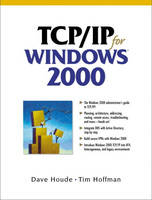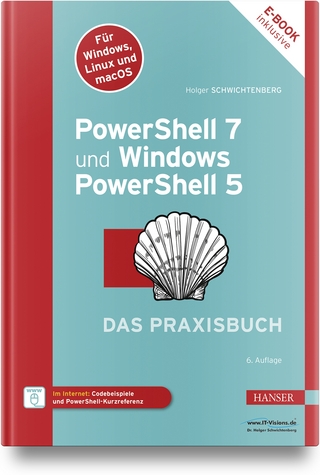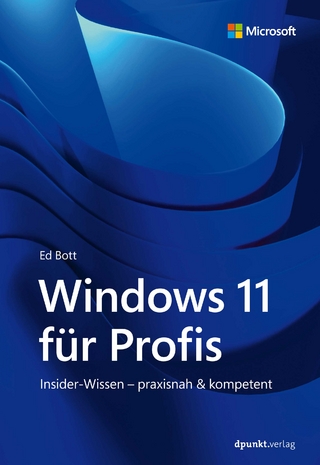
TCP/IP For Windows 2000
Prentice Hall (Verlag)
978-0-13-028160-9 (ISBN)
- Titel ist leider vergriffen;
keine Neuauflage - Artikel merken
For courses in Windows NT and Windows 2000 Networking.
Whether you are new to the suite of protocols called Transmission Control Protocol/Internet Protocol (TCP/IP), want to understand the changes from Windows NT 4.0 to Windows 2000, or need an up-to-date desk reference, this is the book for you. Written to teach TCP/IP at the intermediate level, it contains history, basics, subnetting, Active Directory, DHCP, WINS, SNMP, tools, utilities, challenge questions, review sections and self-study for deeper understanding of the topics.
This book shows you how to set up, configure, use, and support the TCP/IP suite of protocols on Windows 2000. The operational view compliments many of the book on Windows 2000 that now assume a student is already familiar with the new features of TCP/IP on Windows 2000.
DAVE HOUDE is senior engineer for Alida Connection, a leading technology training and consulting firm based in Nashua, NH. TIM HOFFMAN is President of Alida Connection. Together, they have co-authored three Prentice Hall PTR books: MCSE: Internetworking with Microsoft TCP/IP on Microsoft Windows NT 4.0, MCSE: Implementing and Supporting Microsoft Proxy Server 2.0, and Network+ Certification.
Acknowledgments.
Introduction.
1. Introduction to TCP/IP.
TCP/IP Basics. Standards and How They Appear. Advantages of TCP/IP. TCP/IP Utilities and Services. Installing Microsoft TCP/IP on Windows 2000. Automatic Configuration. Manually Configuring TCP/IP. Changing TCP/IP Parameters. Testing the TCP/IP Configuration. TCP/IP Testing Sequence. Microsoft Network Monitor. Installing Microsoft Network Monitor. Using Microsoft Network Monitor to Capture and View Data. Summary. Test Yourself.
2. Windows 2000 Active Directory Overview.
Directory Services and the Active Directory. User Management with Active Directory. Active Directory Features. Quality of Service. Summary. Test Yourself.
3. TCP/IP Architecture.
ISO/OSI and DoD Overview. The Open Systems Interconnect Model. DoD Four-Layer Model. The Microsoft TCP/IP Protocol Suite. Address Resolution Protocol. ARP Packet Structure. Internet Control Message Protocol (ICMP). Internet Group Management Protocol. Internet Protocol. Transmission Control Protocol. User Datagram Protocol. Ports and Sockets. Summary. Test Yourself.
4. IP Addressing.
Defining IP Addresses. Dotted Decimal Notation. Network ID and Host ID. Defining Address Classes. Class A. Class B. Class C. Class D. Class E. Assigning IP Addresses. Choosing a Network ID. Selecting the Right Amount of Network IDs. Choosing the Host ID. Valid and Invalid Host IDs and Network IDs. Configuring Microsoft TCP/IP to Support Multiple Network Adapters. Defining Subnet Masks. Default Subnet Masks. Using the Subnet Mask. Summary. Test Yourself.
5. Subnetting.
Defining Subnets. Planning Considerations. Design Considerations. Changing Custom Subnet Mask Defaults. Defining the Subnet Numbers. Defining Host Addresses for Each Subnet. Supernetting. Subnetting in Action. Summary. Test Yourself.
6. IP Routing.
Routing Basics. Host Routing. Routing Table. TCP/IP Dead Gateway Detection. Router's Decisions. Types of Routing. Static Routing. Configuring a Windows 2000 Server Computer to Function as a Static IP Router. Modifying the Routing Table. Dynamic Routing. Routing Internet Protocol. Open Shortest Path First. Windows 2000 Computer as a Dynamic Router. Static and Dynamic Routers in the Same Network. Using the TRACERT Utility to Verify IP Routes. Summary. Test Yourself.
7. Automatic Private IP Addressing and DHCP.
Automatic Private IP Addressing. The APIPA Process. The DHCP Process. DHCP Lease Duration. Installing DHCP on a Windows 2000 Server. Configuring DHCP Scopes and Options. Adding a Scope. Configuring DHCP Options. Authorizing DHCP in Active Directory. DHCP Relay Agent. Configuring a Windows 2000 Server as a DHCP Relay Agent. DHCP Planning Considerations. Clients. Subnets. Servers. Options. Client Configuration. IPCONFIG and IP Parameters. Managing the DHCP Database. Database Backup and Restoration. Compacting the Database. Files Used by the DHCP Database. Analyzing the Impact of DHCP Traffic on the Network. IP Address Lease Acquisition. Address Lease Renewal. DHCP Traffic Optimization. Summary. Test Yourself.
8. NetBIOS Over TCP/IP.
NetBIOS Names. NetBIOS Name Registration, Discovery, and Release. Name Registration. Name Discovery. Name Release. NetBIOS Name Scopes. NetBIOS Name Resolution. Standard Name Resolution Methods. Microsoft Name Resolution Methods. Broadcast Name Resolution. Using a NetBIOS Name Server to Resolve Names. Name Resolution Nodes. B-node. P-node. M-node. H-node. DNS Name Resolution. The LMHOSTS File. LMHOSTS Keywords. Enabling LMHOSTS Lookup and Importing LMHOSTS Files. LMHOSTS Name Resolution Problems. Using NBTSTAT. Microsoft Methods of Resolving NetBIOS Names. Disabling NetBIOS. Summary. Test Yourself.
9. Implementing Windows Internet Name Service.
The WINS Process. Name Registration. Name Renewal. Name Release. Name Query/Response. WINS Planning Considerations. WINS Implementation. WINS Installation. Configuring Static Entries and Proxy Agents. Static Entries. WINS Proxy Agents. WINS Client Configuration. Primary/Secondary WINS Servers. Database Replication Between WINS Servers. Configuring WINS Database Replication. Automatic Replication Partners. WINS Server Configuration. Burst Handling. The WINS Database. WINS Database Maintenance. Summary. Test Yourself.
10. IP Internetwork Browsing and Domain Functions.
Browsing Overview. Browser Roles. Browsing in One IP Subnet. How Does the Computer Get into the Browse List? Master Browser. Backup Browser. What Happens When a Computer Needs to Browse? When Does the Computer Disappear from the Browse List? Browser Elections. Browsing Across Subnets. The IP Router Solution. Domain Master Browser. LMHOSTS File Solution. WINS Solution. DNS Solution. Domain Functions in the TCP/IP Environment. LMHOSTS Solution. WINS Solution. DNS Solution. Summary. Test Yourself.
11. Host Name Resolution.
TCP/IP Naming Schemes. Defining Host Names. Host Name Resolution. Standard Name Resolution Methods. Microsoft Name Resolution Methods. Name Resolution Using a HOSTS File. Name Resolution Using a DNS Server. The Microsoft Host Name Resolution Process. Configuring the HOSTS File. Summary. Test Yourself.
12. Domain Name System.
The Need for a Domain Name System. The Domain Name System. Resolvers. Name Servers. Domain Name Space. Zones of Authority. Roles for Name Servers. Primary Name Servers. Secondary Name Servers. Master Name Servers. Caching-Only Servers. Forwarders. Slaves. DNS Name Resolution. Recursive Query. Iterative Query. Inverse Query. Caching and Time to Live. DNS Files. Database File. Reverse Lookup File. 127-Reverse Lookup File. Cache File. Boot File. DNS Implementation Planning. DNS Installation and Configuration. Installing the Service. Configuring the DNS Server. Integrating DNS with Other Name Servers. Connecting DNS to a DNS Root Server. Connecting DNS to a WINS Server. Configuring a DNS Server for WINS Lookup. Delegating Zones. Configuring DNS Server Roles. Primary Name Server. Secondary Name Server. Master Name Server. Caching-Only Server. Forwarder. Configuring a DNS Client. Using NSLOOKUP for DNS Troubleshooting. Some Useful NSLOOKUP Commands. Summary. Test Yourself.
13. DNS: Integration with Active Directory.
Active Directory Service Integration. Storage and Replication. Active Directory Zone Objects. DNS Dynamic Update. Dynamic Update Process. Dynamic Update Failure. Time to Live. Resolving Name Conflicts. Secure Dynamic Update. DNS Strategies for the Windows 2000 Domain. Use Your Registered DNS Domain Name for the Active Directory Root. Use a Delegated DNS Subdomain for the Active Directory Root. Use a Single DNS Domain Name for the Internal and External Networks. Use a Different DNS Domain Name for the Internal and External Networks. Summary. Test Yourself.
14. IPSec and RRAS.
IPSec. IPSec Negotiation and Encryption Process. Security Policies. Configuring IPSec. Routing and Remote Access Service-Routing. Configure and Enable RRAS. Configure a Static Router. Network Address Translation. Dynamic Routing. Multicast Routing. Routing and Remote Access Service-Virtual Private Networking. How Does PPTP Work? Layer Two Tunneling Protocol. Configuring a VPN. Routing and Remote Access Service-Dial-Up Networking. Serial Line Internet Protocol. Point-to-Point Protocol. Configuring a Dial-In Server. Configuring a Dial-Up Router. Dial-Up Client Configuration. General RRAS Server Configuration. Remote Access Policies and the Active Directory. Summary. Test Yourself.
15. Connectivity in Heterogeneous Environments.
Microsoft TCP/IP Connectivity Utilities. Connectivity Using Microsoft TCP/IP Utilities. Data Transfer Utilities. Remote Execution Utilities. Configuring a Windows 2000 Computer to Support TCP/IP Printing. TCP-IP Printing Utilities. Submitting Print Jobs Using LPR. Configuring Print Manager with LPR. Using Windows 2000 as a Print Gateway. Summary. Test Yourself.
16. Simple Network Management Protocol.
Defining SNMP. SNMP Communities. The SNMP Service on Microsoft Windows 2000. Management Information Base. Installing and Configuring SNMP on Windows 2000. Summary. Test Yourself.
17. Troubleshooting Microsoft TCP/IP.
General Considerations. Windows 2000 Diagnostic Tools Overview. TCP/IP Troubleshooting Guidelines. Identifying the TCP/IP Configuration. Incorrect IP Address Assignment. Subnet Mask Problems. Testing IP Communications. Routing Problems. Testing TCP/IP Name Resolution. NetBIOS Name Resolution Problems. Host Name Resolution Problems. Session Communications Problems. Summary. Test Yourself.
Appendix: Answers to Review Questions.
Index.
| Erscheint lt. Verlag | 15.6.2001 |
|---|---|
| Verlagsort | Upper Saddle River |
| Sprache | englisch |
| Maße | 178 x 234 mm |
| Gewicht | 988 g |
| Themenwelt | Informatik ► Betriebssysteme / Server ► Windows |
| Informatik ► Betriebssysteme / Server ► Windows Server | |
| Informatik ► Netzwerke ► TCP / IP und IPv6 | |
| ISBN-10 | 0-13-028160-3 / 0130281603 |
| ISBN-13 | 978-0-13-028160-9 / 9780130281609 |
| Zustand | Neuware |
| Haben Sie eine Frage zum Produkt? |
aus dem Bereich


